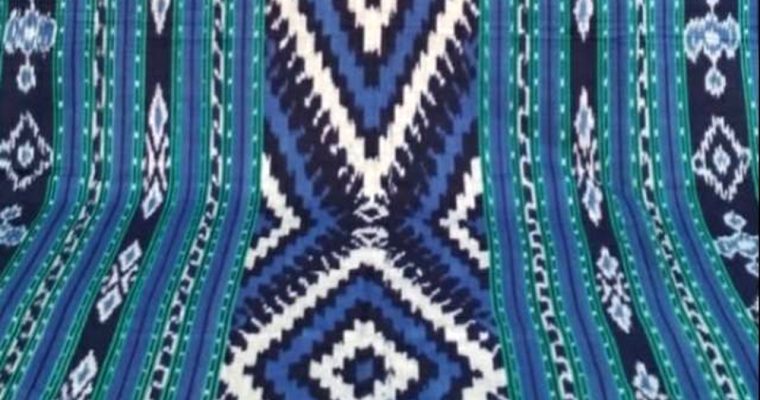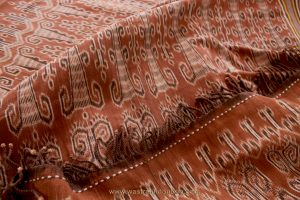It aches my heart when I find a textile sold online with false information, cheating potential buyers with misleading details. The victims are usually textile lovers who do not have not much clues about the origin of certain textiles and who are desperate to add something valuable to their collections. An image of a Troso textile was sent to me yesterday and was being traded on the Internet for nearly US $150, with cheating details as follows ” This is a mid-20th century Sumba Indonesian cotton ikat textile. The weave is of mid-fineness” …. Oops!!
The motifs were not even Sumba, they were actually copied from Central Timor Ikat motifs, mixed with other motifs, transferred onto cheap cotton yarns, and woven using a shaft loom in Troso, Central Java. This image was actually sent to me by someone who was very interested in buying it, but curious about the details and the frills.
Do you know that there are so many sad souls out there, preying on the vulnerable kind textile collectors, telling lies in order to gain profit? They may have purchased it for $10 in Bali or Java, but trying to make a good profit by lying about their origin or their condition.
PLEASE BE ADVISED, that Troso Ikat, is indeed Indonesian Textile, but they are made for commercial purposes, not for traditional purposes and the quality will never be the same as that of handmade traditional textiles. Because of the nature of their motifs, and the Indonesian people have adopted these textiles like traditional textiles, these textiles do not have any traditional ceremonial value, they are made just for commercial purposes. They are not like the Indonesian traditional textiles made by weavers in weaving villages across the archipelago.
I have been contacted so many times about Troso textiles, and how people were crying when they found out that their Internet Purchased Troso textiles, are not actually handwoven using backstrap-loom and they are not actually the Sumba or Timor textiles they were longing to own.
Nobody is denying that Troso ikat textiles are made by hand and of course operated by their feet too, in other words, they are made by Shaft loom, usually operated by strong men, as the shaft loom is fairly heavy. Indeed, Troso ikat is prepared using the Ikat method. They may have transferred the motifs onto the yarn using a printing method (not hand-drawn as they do by the traditional textile artisans), but the dying process uses a resist method, much like the traditional one. However, they can do mass-production of this ikat according to buyers’ demand.
In Indonesia is like a real “Civil Textile War” between the traditional weavers in weaving villages across the archipelago, and the shaft weavers of Central Java. The reason for this war (well…. let’s call it massive clashes), it is because the Troso weavers can produce/will produce any patterns of any traditional textiles from around Indonesia (no respect for the culture behind them), copied onto cheap cotton or any other yarn, make them look like the real traditional textile. Sometimes, they can put several traditional motifs on the same textile, for example, a Sumba motif mixed with Timor motifs, and call it Sumba, or whatever they fancy.
I have been looking into these textiles for years, and only after connecting to so many of the makers in Troso, did I come to understand this textile war. They told me that they are producing textiles, according to the demand from their buyers. They never lied about their textiles and never once told anyone that their textiles are traditional textiles and that these textiles are not made by traditional weavers.
The problems are nested in the hands of the “CROOKS”, who bought the cheap textiles and sold them on as traditional textiles of museum quality to buyers who knew nothing about TROSO and knew very little about the real Indonesian traditional textiles.
I suppose the story of Troso Textile is a bit like trying to own a real “CHANEL” handbag, so expensive to buy, so there are markets for the fake channels, made from leather, labelled exactly the same, sometimes hard to spot the difference. You can get these copies in unregulated marketplaces around the globe.
The “Chanel” dilemma, applies to our Indonesian traditional textiles, the real traditional textiles are hard to make and not cheap to buy. So many lovers, but also so many crooks, just like any other art in the world. My advice is please just be careful about what you purchase. Ask questions before buying them. If you are starting a new hobby, collecting traditional textiles, please study the textiles and their histories, their stories, and their function, before collecting them. It will be worth it when you find your dream textiles.
As a lover of traditional textiles who works closely with the weavers from around Indonesia, I do feel very sad for the traditional weavers. There is a huge challenge for them to compete with the Troso weavers. On the other hand, I am still grateful that the copies of our textiles are still produced in Indonesia, by Indonesian artisans who also need to survive. I will be crying like crazy if one day, the Chinese start laying their hands on our textiles, just like they do with fake designer items from around the globe.
Now.. I wonder how those designers feel about their items being copied and sold as the real McCoy when they are actually fake ones!! I would be gutted if that happened to my designs!! So, it is really up to us, to choose and learn.
Sorry for this long share, I have been wanting to share this story for years. I hope I haven’t bored you with it. I hope your Indonesian textile hunting experience will be an amazing one.
Take care, stay safe, and stay happy, Christmas is on its way.
Salam Wastra,
Nelly Andon Br Torus


